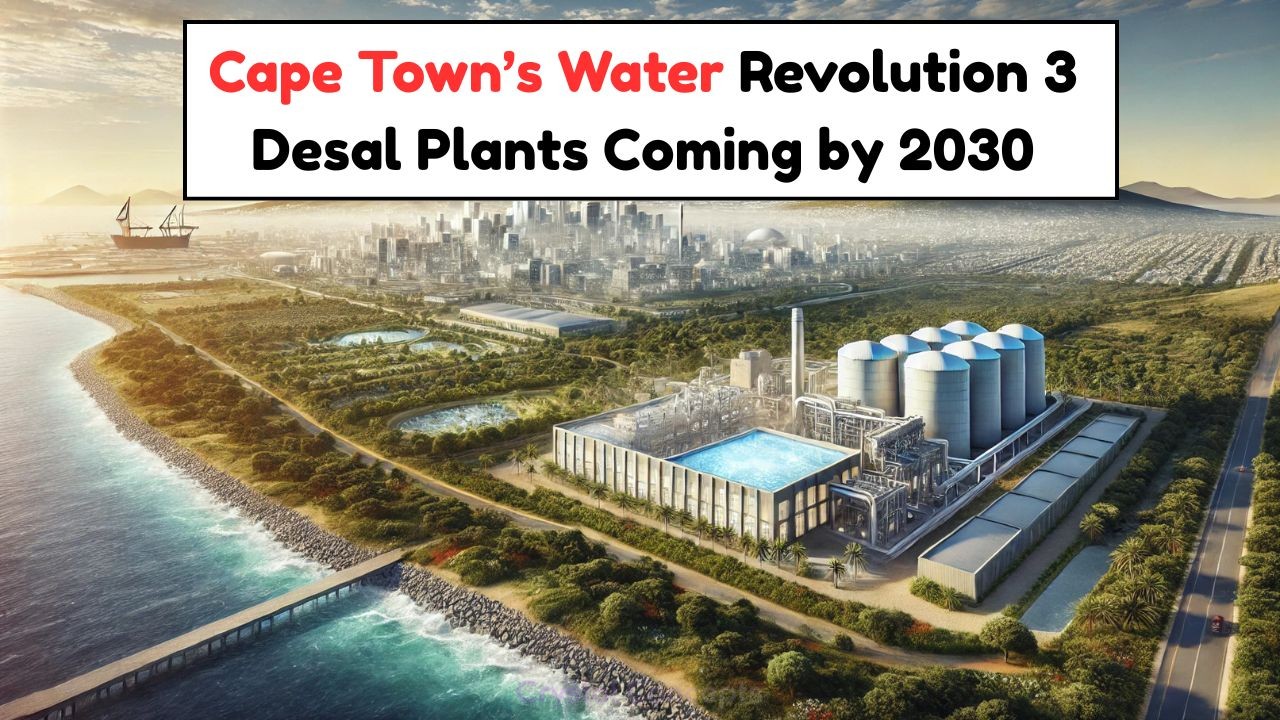Cape Town’s Bold 2030 Vision: Can 3 New Desalination Plants Solve the Water Crisis?: As Cape Town grapples with the persistent challenges of water scarcity, the city has embarked on an ambitious plan to address its water crisis. By 2030, Cape Town aims to construct three new desalination plants, a bold vision that promises to transform seawater into potable water for the city’s residents. This initiative is not just a response to an immediate need, but a strategic move towards long-term sustainability. The question remains: can these desalination plants truly solve the water crisis that has long plagued this vibrant city? With technological advancements and strategic planning, Cape Town’s efforts could set a precedent for other regions facing similar challenges.
Understanding the 2030 Vision for Desalination
The 2030 vision for desalination in Cape Town is an ambitious project aimed at securing a reliable water supply for the city’s growing population. The plan involves constructing three new desalination plants along the coast, each with its unique capabilities and technologies. These plants will convert seawater into drinking water, helping to alleviate the pressure on existing water resources. The strategic locations of these plants are chosen to maximize efficiency and minimize environmental impact.
- Plant 1: Located near the bustling V&A Waterfront, this plant will focus on serving the central business district and surrounding areas.
- Plant 2: Situated in the southern suburbs, this facility aims to support residential areas that have experienced significant growth.
- Plant 3: Positioned on the west coast, this plant will cater to the northern suburbs and industrial sectors.
The Technology Behind Desalination
Desalination technology has evolved significantly over the years, making it a viable option for water-scarce regions like Cape Town. The process involves removing salt and other impurities from seawater, rendering it safe for human consumption. The Cape Town desalination plants will utilize advanced reverse osmosis technology, known for its efficiency and effectiveness in producing high-quality potable water.
 Experts Sound Alarm as Deadly Bird Flu Hits Limpopo: What SA Consumers Need to Know in July
Experts Sound Alarm as Deadly Bird Flu Hits Limpopo: What SA Consumers Need to Know in July
| Plant | Location | Capacity (ML/day) | Technology |
|---|---|---|---|
| Plant 1 | V&A Waterfront | 50 | Reverse Osmosis |
| Plant 2 | Southern Suburbs | 75 | Reverse Osmosis |
| Plant 3 | West Coast | 100 | Reverse Osmosis |
Challenges and Considerations
While the vision for new desalination plants is promising, several challenges and considerations must be addressed. One of the main concerns is the environmental impact of desalination, particularly the disposal of brine, a byproduct of the process. It is crucial to ensure that brine disposal methods do not harm marine ecosystems.
- Environmental Impact: Studies are underway to explore sustainable brine disposal solutions.
- Cost Considerations: Desalination is energy-intensive, and cost-effective energy solutions are being explored.
- Infrastructure Development: Building the necessary infrastructure to support these plants is a complex task.
- Community Engagement: Ensuring public support and understanding of the project is vital.
Potential Impact on Cape Town’s Water Crisis
The potential impact of these desalination plants on Cape Town’s water crisis is significant. By providing a consistent and reliable source of potable water, these facilities can reduce the city’s reliance on traditional water sources, such as dams, which are susceptible to climate variability and droughts. The project aims to not only solve immediate water shortages but also to provide a long-term solution that supports sustainable growth and development.
| Year | Population Served | Water Contribution (%) | Projected Cost (ZAR) |
|---|---|---|---|
| 2025 | 1.5 million | 10 | 3 billion |
| 2030 | 3 million | 25 | 6 billion |
| 2035 | 4.5 million | 40 | 9 billion |
| 2040 | 6 million | 50 | 12 billion |
| 2045 | 7.5 million | 60 | 15 billion |
Community and Environmental Benefits
The introduction of desalination plants in Cape Town brings numerous benefits to both the community and the environment. By diversifying water sources, the city can ensure a stable supply that supports economic activities and improves the quality of life for residents.
- Reduced Dependence on Dams: Less stress on traditional water sources.
- Job Creation: Construction and operation of plants provide employment opportunities.
- Resilience to Climate Change: A diversified water supply system enhances adaptability.
- Environmental Protection: Efforts are made to minimize ecological impacts.
Future Prospects and Developments
| Year | Milestone | Goal | Outcome |
|---|---|---|---|
| 2024 | Planning Phase | Complete Environmental Studies | Achieved |
| 2026 | Construction Begin | Start Building All Plants | In Progress |
| 2028 | First Plant Operational | Commence Operations | Pending |
| 2030 | All Plants Operational | Full Capacity Operation | Scheduled |
| 2035 | Evaluation | Assess Impact on Water Supply | Pending |
Public Perception and Support
The success of Cape Town’s desalination vision heavily relies on public perception and support. Engaging with communities to raise awareness about the benefits and challenges of desalination is essential. Public consultation sessions, educational campaigns, and transparent communication strategies are being employed to foster trust and collaboration.
- Awareness Campaigns: Informing the public about desalination processes and benefits.
- Feedback Mechanisms: Establishing channels for public input and feedback.
- Collaborative Projects: Partnering with local organizations to promote sustainability.
- Transparency: Regular updates on project progress and outcomes.
- Educational Initiatives: Schools and universities incorporate water conservation education.
FAQs on Cape Town’s Desalination Plants
| Question | Answer |
|---|---|
| What is the main goal of Cape Town’s desalination plants? | The main goal is to provide a reliable and sustainable water supply for the city. |
| How does desalination impact the environment? | Efforts are made to minimize environmental impact, especially concerning brine disposal. |
| When will the desalination plants be operational? | The first plant is expected to be operational by 2028, with all plants fully operational by 2030. |
| What technology is used in the desalination process? | Advanced reverse osmosis technology is used for efficient seawater conversion. |
| How is the community involved in the desalination project? | Through awareness campaigns, public consultations, and educational initiatives. |
Long-term Vision for Water Sustainability
Looking Beyond 2030
As Cape Town looks beyond 2030, the focus remains on ensuring water sustainability for future generations. The desalination plants are part of a broader strategy that includes water conservation, recycling, and infrastructure development. By adopting a holistic approach, Cape Town aims to become a model city for water management in a changing climate.
Innovative Approaches to Water Management
Future developments may include exploring alternative water sources, such as rainwater harvesting and greywater systems. Technological innovations and community engagement will be key to achieving these goals.
Continuous Improvement and Adaptation
Regular evaluations and updates to the water management strategy will ensure that Cape Town remains resilient to water challenges. Flexibility and adaptation are crucial as environmental conditions evolve.
Global Lessons and Collaboration
Cape Town’s experience with desalination offers valuable lessons for other cities facing similar challenges. Collaboration with international partners can lead to shared knowledge and improved water solutions worldwide.
Commitment to Sustainability
Ultimately, Cape Town’s commitment to sustainability and innovation in water management reflects a dedication to preserving natural resources and ensuring a thriving future for its residents.









